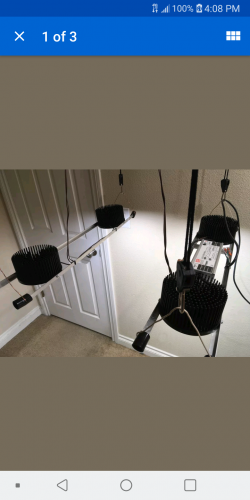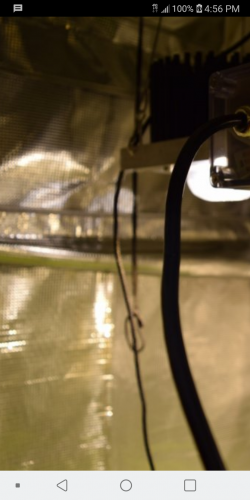cyberlocc
Chameleon Enthusiast
Hey, so I have been seeing a lot of posts about LEDs and grow lights, and people wanting to bust out of the normal as of late.
Me and some other members have been exploring some Advanced lighting techniques in a push to bring Chameleon lighting to a new plane. Rather than continuously hijack others threads, I thought it was time we had a place to go with our ramblings, and crazy talk , in our search for the best lighting we can find or build!
, in our search for the best lighting we can find or build!
WARNING: If you attempt, anything in this thread, construct anything found here, or whatever, you are doing so at your own risk. If you burn your house down, electrocute the cat, catch your cage on fire, or whatever, no one here is responsible. This thread, is for people with an understanding of electrical safety!
As a Precursor there is some lighting terms, you are going to see thrown around a lot. We will go over a few of them, to help you in your comprehending in the thread. Please do not ask what these terms mean, as that means you didn't read this post, and will likely Electrocute your Cat! Seriously though, please familiarize yourself with this stuff, so we do not have to keep explaining the same things, instead of making progress.
Glossary of Terms: (Sources + Further Info can be found in the * Link after every definition,)
Light Spectrum: is the many different wavelengths of energy produced by a light source. Light is measured in nanometers (nm). Each nanometer represents a wavelength of light or band of light energy. Visible light is the part of the spectrum from 380nm to 780nm. *
Nanometer (NM): The nanometre is often used to express dimensions on an atomic scale: the diameter of a helium atom, for example, is about 0.1 nm, and that of a ribosome is about 20 nm. The nanometre is also commonly used to specify the wavelength of electromagnetic radiation near the visible part of the spectrum: visible light ranges from around 400 to 700 nm. *
Color Temperature: color temperature of a light source is the temperature of an ideal black-body radiator that radiates light of a color comparable to that of the light source. *
Lux (LX): The lux (symbol: lx) is the SI derived unit of illuminance and luminous emittance, measuring luminous flux per unit area. It is equal to one lumen per square metre. *
Photosynthetically Active Radiation (PAR): The amount of light available for photosynthesis, which is light in the 400 to 700 nano-meter(nm) wavelength range. *
Photosynthetically Useable Radiation (PUR): PUR differs from PAR because the basic definition of PAR is any light in a specific frequency range. PUR is the usable portion of PAR, and different photosynthetic species will have a different PUR range to which they respond. *
Photosynthetic Photon Flux (PPF): Measures the total amount of light that is produced by a light source each second. Put another way, PPF tells us how much PAR is emitted by a light source per second. *
Photosynthetic Photon Flux Density (PPFD): Measures the light that actually arrives at the plant or algae. Photosynthetic Photon Flux Density or “PPFD” is a measurement of the amount of light that actually reaches your plants and algae or, as a scientist might say: “the number of photosynthetically active photons that fall on a given surface each second”. *
Daily Light Integral (DLI): Measures the total amount of light that is delivered to a plant every day. The grower can think of DLI as the plant’s daily “dose” of light, though a scientist would probably say DLI is a cumulative measurement of the total number of photons that reach the plants and algae during the daily photoperiod. DLI measures the number of “moles” of photons per square meter per day and is expressed as: mol/m2/d. *
(a cool calculator to convert, any above measurement to DLI - https://curiousplant.com/light-carnivorous-plants-part-2/, calcs near the bottom of the page)
LED (Light Emitting Diode): is a two-lead semiconductor light source. It is a p–n junction diode that emits light when activated. *
Array: LED arrays are assemblies of LED packages or dies that can be built using several methods. Each method hinges on the manner and extent to which the chips themselves are packaged by the LED semiconductor manufacturer. The intensity and uniformity of light output from an array depends upon the method of LED array manufacturing used. *
Types of Arrays *
Types of Drivers *
Types of LED control
Diffuser: In optics, a diffuser (also called a light diffuser or optical diffuser) is any material that diffuses or scatters light in some manner to transmit soft light. Diffuse light can be easily obtained by reflecting light from a white surface, while more compact diffusers may use translucent material, including ground glass, teflon, holographs, opal glass, and greyed glass. *
Enjoy the thread
Me and some other members have been exploring some Advanced lighting techniques in a push to bring Chameleon lighting to a new plane. Rather than continuously hijack others threads, I thought it was time we had a place to go with our ramblings, and crazy talk
WARNING: If you attempt, anything in this thread, construct anything found here, or whatever, you are doing so at your own risk. If you burn your house down, electrocute the cat, catch your cage on fire, or whatever, no one here is responsible. This thread, is for people with an understanding of electrical safety!
As a Precursor there is some lighting terms, you are going to see thrown around a lot. We will go over a few of them, to help you in your comprehending in the thread. Please do not ask what these terms mean, as that means you didn't read this post, and will likely Electrocute your Cat! Seriously though, please familiarize yourself with this stuff, so we do not have to keep explaining the same things, instead of making progress.
Glossary of Terms: (Sources + Further Info can be found in the * Link after every definition,)
Light Spectrum: is the many different wavelengths of energy produced by a light source. Light is measured in nanometers (nm). Each nanometer represents a wavelength of light or band of light energy. Visible light is the part of the spectrum from 380nm to 780nm. *
Nanometer (NM): The nanometre is often used to express dimensions on an atomic scale: the diameter of a helium atom, for example, is about 0.1 nm, and that of a ribosome is about 20 nm. The nanometre is also commonly used to specify the wavelength of electromagnetic radiation near the visible part of the spectrum: visible light ranges from around 400 to 700 nm. *
Color Temperature: color temperature of a light source is the temperature of an ideal black-body radiator that radiates light of a color comparable to that of the light source. *
- Kelvin (K): Color temperature is conventionally expressed in kelvin, using the symbol K, a unit of measure for absolute temperature.
- Black Body: is an idealized physical body that absorbs all incident electromagnetic radiation, regardless of frequency or angle of incidence.
Lux (LX): The lux (symbol: lx) is the SI derived unit of illuminance and luminous emittance, measuring luminous flux per unit area. It is equal to one lumen per square metre. *
Photosynthetically Active Radiation (PAR): The amount of light available for photosynthesis, which is light in the 400 to 700 nano-meter(nm) wavelength range. *
Photosynthetically Useable Radiation (PUR): PUR differs from PAR because the basic definition of PAR is any light in a specific frequency range. PUR is the usable portion of PAR, and different photosynthetic species will have a different PUR range to which they respond. *
Photosynthetic Photon Flux (PPF): Measures the total amount of light that is produced by a light source each second. Put another way, PPF tells us how much PAR is emitted by a light source per second. *
Photosynthetic Photon Flux Density (PPFD): Measures the light that actually arrives at the plant or algae. Photosynthetic Photon Flux Density or “PPFD” is a measurement of the amount of light that actually reaches your plants and algae or, as a scientist might say: “the number of photosynthetically active photons that fall on a given surface each second”. *
Daily Light Integral (DLI): Measures the total amount of light that is delivered to a plant every day. The grower can think of DLI as the plant’s daily “dose” of light, though a scientist would probably say DLI is a cumulative measurement of the total number of photons that reach the plants and algae during the daily photoperiod. DLI measures the number of “moles” of photons per square meter per day and is expressed as: mol/m2/d. *
(a cool calculator to convert, any above measurement to DLI - https://curiousplant.com/light-carnivorous-plants-part-2/, calcs near the bottom of the page)
LED (Light Emitting Diode): is a two-lead semiconductor light source. It is a p–n junction diode that emits light when activated. *
Array: LED arrays are assemblies of LED packages or dies that can be built using several methods. Each method hinges on the manner and extent to which the chips themselves are packaged by the LED semiconductor manufacturer. The intensity and uniformity of light output from an array depends upon the method of LED array manufacturing used. *
Types of Arrays *
- COB (Chip On Board): In Chip-on-Board LED Arrays, the bare chip is placed in direct contact with the substrate.
- Packaged LEDs (AKA "LED Array", or Just "Array"): A packaged LED has an optical lens, bonding wire, electrodes, and resin to encapsulate the LED for protection.
Types of Drivers *
- Constant Current (CC): Constant current LED drivers are designed for a designated range of output voltages and a fixed output current (mA). LEDs that are rated to operate on a constant current driver require a designated supply of current usually specified in milliamps (mA) or amps (A)
- Constant voltage (CV): Constant voltage drivers are designed for a single direct current (DC) output voltage. Most common constant voltage drivers (or Power Supplies) are 12VDC or 24VDC. An LED light that is rated for constant voltage usually specifies the amount of input voltage it needs to operate correctly.
Types of LED control
- Pulse-width modulation (PWM): is a modulation process or technique used in most communication systems for encoding the amplitude of a signal right into a pulse width or duration of another signal, usually a carrier signal, for transmission. *
- Analog Output (0-Xv): Hardware interfaces that output non-digital signals *
Diffuser: In optics, a diffuser (also called a light diffuser or optical diffuser) is any material that diffuses or scatters light in some manner to transmit soft light. Diffuse light can be easily obtained by reflecting light from a white surface, while more compact diffusers may use translucent material, including ground glass, teflon, holographs, opal glass, and greyed glass. *
Enjoy the thread
Last edited:







